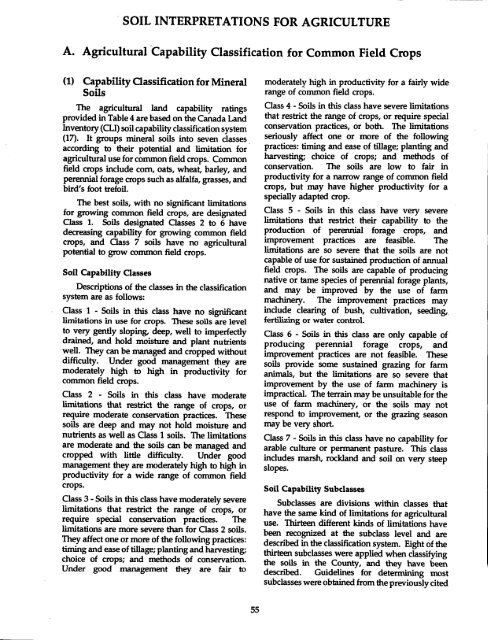The Soils of Elgin County - Agriculture and Agri-Food Canada
The Soils of Elgin County - Agriculture and Agri-Food Canada
The Soils of Elgin County - Agriculture and Agri-Food Canada
- No tags were found...
Create successful ePaper yourself
Turn your PDF publications into a flip-book with our unique Google optimized e-Paper software.
SOIL INTERPRETATIONS FOR AGRICULTUREA .<strong>Agri</strong>cultural Capability Classification for Common Field Crops(1) Capability Classification for Mineral<strong>Soils</strong><strong>The</strong> agricultural l<strong>and</strong> capability ratingsprovided in Table 4 are based on the <strong>Canada</strong> L<strong>and</strong>Inventory (CLI) soil capability classification system(17) . It groups mineral soils into seven classesaccording to their potential <strong>and</strong> limitation foragricultural use for common field crops. Commonfield crops include corn, oats, wheat, barley, <strong>and</strong>perennial forage crops such as alfalfa, grasses, <strong>and</strong>bird's foot trefoil.<strong>The</strong> best soils, with no significant limitationsfor growing common field crops, are designatedClass 1 . <strong>Soils</strong> designated Classes 2 to 6 havedecreasing capability for growing common fieldcrops, <strong>and</strong> Class 7 soils have no agriculturalpotential to grow common field crops .Soil Capability ClassesDescriptions <strong>of</strong> the classes in the classificationsystem are as follows :Class 1 - <strong>Soils</strong> in this class have no significantlimitations in use for crops . <strong>The</strong>se soils are levelto very gently sloping, deep, well to imperfectlydrained, <strong>and</strong> hold moisture <strong>and</strong> plant nutrientswell . <strong>The</strong>y can be managed <strong>and</strong> cropped withoutdifficulty . Under good management they aremoderately high to high in productivity forcommon field crops .Class 2 - <strong>Soils</strong> in this class have moderatelimitations that restrict the range <strong>of</strong> crops, orrequire moderate conservation practices . <strong>The</strong>sesoils are deep <strong>and</strong> may not hold moisture <strong>and</strong>nutrients as well as Class 1 soils . <strong>The</strong> limitationsare moderate <strong>and</strong> the soils can be managed <strong>and</strong>cropped with little difficulty. Under goodmanagement they are moderately high to high inproductivity for a wide range <strong>of</strong> common fieldcrops .Class 3 - <strong>Soils</strong> in this class have moderately severelimitations that restrict the range <strong>of</strong> crops, orrequire special conservation practices . <strong>The</strong>limitations are more severe than for Class 2 soils .<strong>The</strong>y affect one or more <strong>of</strong> the following practices :timing <strong>and</strong> ease <strong>of</strong> tillage; planting <strong>and</strong> harvesting;choice <strong>of</strong> crops; <strong>and</strong> methods <strong>of</strong> conservation .Under good management they are fair tomoderately high in productivity for a fairly widerange <strong>of</strong> common field crops.Class 4 - <strong>Soils</strong> in this class have severe limitationsthat restrict the range <strong>of</strong> crops, or require specialconservation practices, or both. <strong>The</strong> limitationsseriously affect one or more <strong>of</strong> the followingpractices : timing <strong>and</strong> ease <strong>of</strong> tillage, planting <strong>and</strong>harvesting; choice <strong>of</strong> crops; <strong>and</strong> methods <strong>of</strong>conservation . <strong>The</strong> soils are low to fair inproductivity for a narrow range <strong>of</strong> common fieldcrops, but may have higher productivity for aspecially adapted crop.Class 5 - <strong>Soils</strong> in this class have very severelimitations that restrict their capability to theproduction <strong>of</strong> perennial forage crops, <strong>and</strong>improvement practices are feasible. <strong>The</strong>limitations are so severe that the soils are notcapable <strong>of</strong> use for sustained production <strong>of</strong> annualfield crops . <strong>The</strong> soils are capable <strong>of</strong> producingnative or tame species <strong>of</strong> perennial forage plants,<strong>and</strong> may be improved by the use <strong>of</strong> farmmachinery . <strong>The</strong> improvement practices mayinclude clearing <strong>of</strong> bush, cultivation, seeding,_fertilizing or water control.Class 6 - <strong>Soils</strong> in this class are only capable <strong>of</strong>producing perennial forage crops, <strong>and</strong>improvement practices are not feasible . <strong>The</strong>sesoils provide some sustained grazing for farmanimals, but the limitations are so severe thatimprovement by the use <strong>of</strong> farm machinery isimpractical . <strong>The</strong> terrain maybe unsuitable for theuse <strong>of</strong> farm machinery, or the soils may notrespond to improvement, or the grazing seasonmay be very short .Class 7 - <strong>Soils</strong> in this class have no capability forarable culture or permanent pasture. This classincludes marsh, rockl<strong>and</strong> <strong>and</strong> soil on very steepslopes.Soil Capability SubclassesSubclasses are divisions within classes thathave the same kind <strong>of</strong> limitations for agriculturaluse. Thirteen different kinds <strong>of</strong> limitations havebeen recognized at the subclass level <strong>and</strong> aredescribed in the classification system. Eight <strong>of</strong> thethirteen subclasses were applied when classifyingthe soils in the <strong>County</strong>, <strong>and</strong> they have beendescribed. Guidelines for determining mostsubclasses were obtained from the previously cited55
















